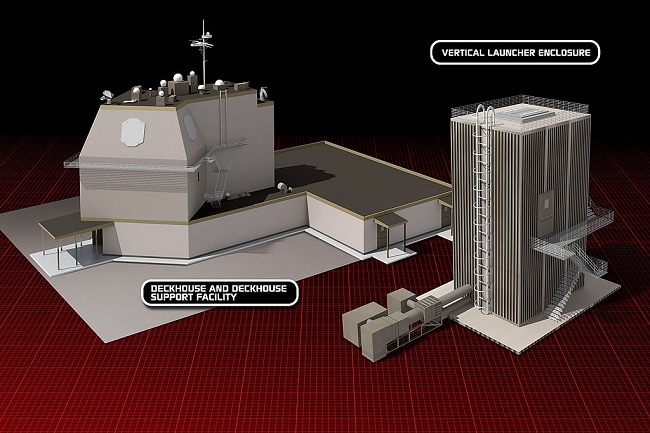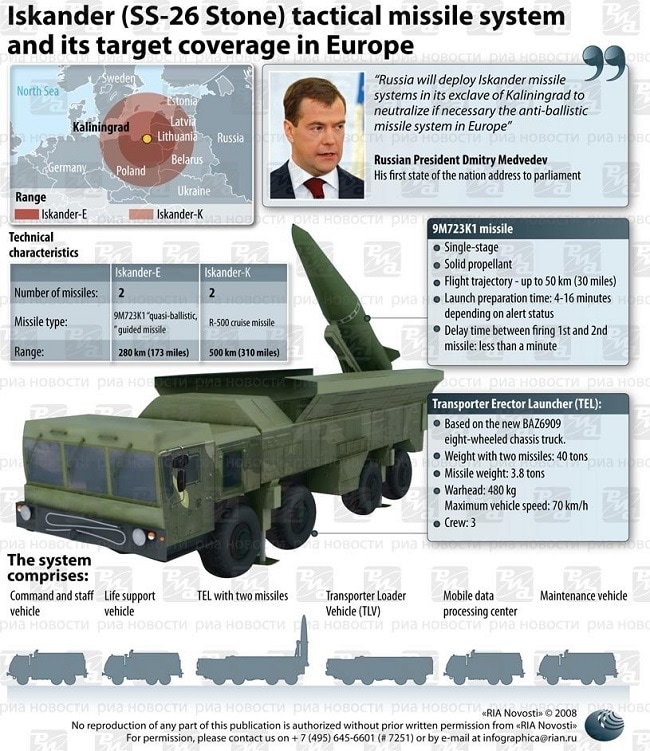On May 12, 2016, the NATO's "Aegis Ashore" ballistic missile defense system became operational at a U.S. naval support facility in Deveselu, Romania. The following day, May 13, the construction of another ballistic-missile defense site officially started in Redzikowo, Poland. Aegis Ashore was first announced by U.S. President Barack Obama in 2009, as part of the European Phased Adaptive Approach (EPAA) aimed at defending Europe against ballistic missile threats originating from outside the "Euro-Atlantic Area." Although U.S. officials stressed that the Aegis Ashore system is defensive and aimed at protecting mainly against threats from Iran, its deployment in Europe prompted strong criticism from Russia.[1] The ballistic missile defense system has been defined by Russian officials as a breach of the 1987 Intermediate Range Nuclear Force Treaty, which required the U.S. and the Soviet Union to eliminate their nuclear and conventional ground-launched ballistic and cruise missiles with ranges of 500 to 5,500 km. Referring to NATO and the U.S as "twins,"[2] Russian Foreign Ministry Spokesperson Maria Zakharova stated that since Russia's concerns towards the ballistic missile defense system continue to be "ignored," Moscow is reaching the appropriate conclusions, "including in terms of a military-technical response."[3] Russian military officials also stated that Russia will respond militarily to the NATO's Ballistic Missile Defense system.

U.S. Deputy Secretary of
Defense Bob Work with Polish and U.S. leaders at the Aegis Ashore missile
defense system groundbreaking ceremony in Redzikowo, Poland. (Source:
Defense.gov, May 13, 2016)

Aegis
Ashore Complex 3D (Source: Defenseindustrydaily.com)
Russian Deputy Prime Minister Rogozin: "There Will Be A Response - A Military-Technological And Modern Response"
After a May 13, 2016 meeting on the defense industry development with Russian President Vladimir Putin, Dmitry Rogozin, deputy prime minister in charge of military industries, stressed that Russia will respond "militarily" to the NATO's Ballistic Missile Defense system. However, he said that the response will be "inexpensive: "Surely, there will be a response. A military-technological and modern response, but inexpensive... We are not getting dragged into an arms race, but we have forces and resources, including those currently being tested, which will work not in an old-fashioned way but based on the enemy's vulnerability." He added that Russia will develop resources and allocate the funding "to neutralize any threat with the least resources... Concerning the military industry, we reported to the president... about the most recent work, and tests and changes to the regulations for such tests, which allow us to speed up the creation of a weapon whose technical characteristics are even superior to [those of] the weapon of our probable adversaries."
Rogozin said that the goal of the U.S. is to deploy "interceptor systems" as close to Russia as possible, "so that in the event of a counter or retaliatory strike [from Russia], [the U.S.] can neutralize our forces and resources by simply stopping them from taking off... Basically, it is the same nuclear weapon, only in a non-nuclear version. [Therefore,] we cannot see it as defense [system]."[4]
Maj.-Gen. Matveevskii: Russia Will Deploy Iskander-M Missiles In Kaliningrad Exclave By 2018
Russian missile and artillery infantry forces commander Maj. Gen. Mikhail Matveevskii stressed that Russia will deploy Iskander-M short-range ballistic missiles on the territory of the Kaliningrad exclave between Poland and Lithuania by 2018, in response to the deployment of ballistic missile defense system elements in Eastern Europe.[5] It is worth noting that the Iskander-M is able to strike with conventional and unconventional short-range warheads.[6] Already in 2008, in his first state-of-the-nation message as Russian president to the Federal Assembly on November 5, Dmitry Medvedev said that Russia would deploy Iskander M missiles in Kaliningrad in order to "neutralize" the anti-ballistic missile system in Europe. Medvedev's speech at the time echoed recent Putin's speech against the Aegis Ashore ballistic missile defense system in Romania.[7] He said: "I would add something about what we have had to face in recent years: what is it? It is the construction of a global missile defense system, the installation of military bases around Russia, the unbridled expansion of NATO and other similar 'presents' for Russia - we therefore have every reason to believe that they are simply testing our strength. Of course we will not let ourselves be dragged into an arms race. But we must take this into account in defense expenditures... We will deploy the Iskander missile system in the Kaliningrad Region to be able, if necessary, to neutralize the missile defense system. Naturally, we envisage using the resources of the Russian Navy... And finally, electronic jamming of the new installations of the U.S. missile defense system will be carried out from the territory of the same westernmost region, i.e. from Kaliningrad. I want to emphasize that we have been forced to take these measures. We have repeatedly told our partners [i.e. the U.S.] that we want to engage in positive cooperation. We want to act against common threats and to work together. But unfortunately, very unfortunately, they did not want to listen to us."[8] It is worth noting that Aegis Ashore was first announced by U.S. President Barack Obama in 2009, as part of the European Phased Adaptive Approach (EPAA) aimed at defending Europe against ballistic missile threats originating from outside the "Euro-Atlantic Area." Obama's EPAA canceled a Bush administration plan to deploy Ground-Based Midcourse (GMD) missile defense system in Poland and the Czech Republic.[9]

Iskander tactical missile system and its target coverage in
Europe (Source: RIA Novosti, 2008)
Lenta.ru: "[The U.S. And Russia] Will Shake Hands - While Grinding Teeth - Above Smoking Ruins Of Eastern European Missile Defense Elements"
SUPPORT OUR WORK

The Russian media outlet Lenta.ru published an article by Russian journalist Kostantin Bogdanov stating that Russia might launch a preemptive strike against the U.S. naval support facility in Deveselu, Romania that hoststhe "Aegis Ashore" ballistic missile defense system. It stated: "Bucharest cannot misunderstand it - deploying such a sensitive installation as Aegis Ashore at Deveselu site causes the base to be a priority target for a Russian strike in a hypothetical scenario of a hot confrontation between Moscow and the West. It might not be ruled out that in case of using an 'Aegis' as an offensive weapon - the Russian strike may well be preemptive. The U.S. understands that perfectly, but Washington is far away. Some scenarios of escalation and de-escalation of a 'hot' conflict suggest... that both sides [the U.S. and Russia] will shake hands - while grinding teeth - above smoking ruins of eastern European missile defense elements."
Irina Yarovaya, who chairs the security and anti-corruption committee at the lower house of parliament, the State Duma, stated that the U.S. is dragging Eastern European countries into "military adventurism."[10] The Russian media outlet Politonline.ru, quoting an unnamed military source, said that "Russia is not going to bomb any country" in response to the ballistic missile defense sites in Europe. However, if there will be a threat to Russia, states Polit.ru's unnamed military source, "military airbases with nuclear weapons, warehouses, missile defense sites, seaports and submarines' operational locations" are going to be targeted, adding that "every country does that."[11] Dmitry Gorovzov, deputy chair of the State Duma committee on security, stated that NATO's actions, which follow the "American mood," resemble a "blitzkrieg," the style of warfare used by Nazi Germany in WWII, including against the Soviet Union. "We cannot help but to worry and prepare reciprocate moves," Gorovzov said.[12] The commander of Russia's Strategic Missile Force (SMF), Sergey Karakayev, said that Russia is developing new intercontinental ballistic missiles (ICBMs) with special focus on their ability to penetrate the U.S. missile shield. According to the Russian official, "threats from the U.S. missile defense system in Europe" do not critically reduce the combat capabilities of the Russian Strategic Missile Forces, because Russian missiles are constantly upgraded.[13]
Endnotes:
[1] See MEMRI Special Dispatch No. 6433, Official Russian Campaign Against NATO's Ballistic Missile Defense System In Europe- Part I, May 16, 2016.
[2] Mid.ru, May 12, 2016
[3] See MEMRI Special Dispatch No. 6433, Official Russian Campaign Against NATO's Ballistic Missile Defense System In Europe- Part I, May 16, 2016.
[4] Interfax.com, May 13, 2016.
[5] Gazeta.ru, May 16, 2016.
[6] See MEMRI Special Dispatch No. 6374, Russian Officials: Russia Is Ready To Militarily Answer NATO's Growing Potential In Europe, April 5, 2016.
[7] See MEMRI Special Dispatch No. 6433, Official Russian Campaign Against NATO's Ballistic Missile Defense System In Europe- Part I, May 16, 2016.
[8] Dr. János Deák, The military significance of Kaliningrad, Epa.niif.hu
[9] See MEMRI Special Dispatch No. 6433, Official Russian Campaign Against NATO's Ballistic Missile Defense System In Europe- Part I, May 16, 2016.
[10] Ria.ru, May 15, 2016.
[11] Politonline.ru, May 13, 2016.
[12] Ria.ru, May 13, 2016.
[13] Tass.ru, May 10, 2016.




